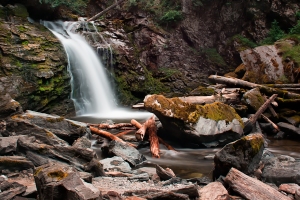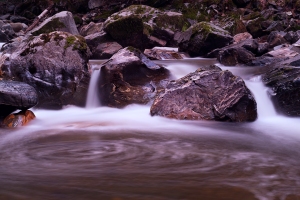A neutral density filter is a clear, colourless, filter that reduces the intensity of all wavelengths, or colours of light, equally. It is usually a colorless (gray) filter that reduces the amount of light entering the lens. A photographer can select exposure combinations that would otherwise produce overexposed pictures. Using a ND filter allows a photographer to achieve a very shallow depth of field, or motion blur.
I’ll begin by saying quality ND filters have always been expensive. During the days of film, the exposure you made was the exposure you got. And when one used colour film one didn’t get a second chance if there was a colour shift, usually a purple cast, with less expensive filters. Some cheap filters weren’t all that sharp either.
I thought about that when during a workshop the leader loaned me a couple Lee filters (over a hundred dollars each) to try on long exposures of the waterfall we were photographing. He indicated if I were to order through him I could get a discount.
I’d already spent a bundle on costs including travel and lodging, and owned ND filters that worked well so I passed on the deal and came home thinking about maybe a future purchase.
My memory of ND filter problems were from the time of film. Film has a permanence that data files created in our modern digital camera don’t have.
Colour balance in film means colour correction filters. Where as, with digital I mostly leave my camera on auto white balance, and fix any shift when I open my RAW files in Photoshop.
A photographer could somewhat help a soft image when shooting black and white film by increasing the contrast, but with colour it was permanent. Nowadays, we have a number of software possibilities that can almost (well, almost) fix a not-quite-in-focus image.
With all that in mind I thought that unless I was making very large prints that those cheap ND filters might be usable. So I ordered several very inexpensive, no-name ND filters thinking the $60.00 or so I spent might be foolish, but I’d have some fun and discard them if they didn’t work.
I bought them, put them away and forgot about them. Then this past week as I sat looking at the overcast sky after a much-needed shower in the parched hills around my home, I decided to give those filters a try. I grabbed my camera, tripod, and the bag of filters, talked my wife into coming, and drove to a local waterfall.
The Chase Creek falls weren’t the raging torrent of spring or early summer. This year’s long, hot, dry spell has had an effect and capturing an exciting waterfall wasn’t possible. I tried a couple different angles, scrambling around the rocks and down to a now sandy shore, and then a group of young people came to splash in the cold water so I moved downstream in the creek. I was getting bored anyway and didn’t mind giving up my spot to those kids and their blanket.
Returning home, I loaded my RAW files in the computer, easily corrected the white balance, added contrast and sharpened the image in Photoshop.
My conclusion is those inexpensive ND filters are great if one is willing to shoot in RAW and make post-production corrections. I think an out-of-the-camera JPG would be disappointing.
I expect there will be opinions by experienced photographers who read this. However, the images look pretty good on my calibrated 30-inch Mac display screen. I haven’t made any prints, but I expect 8×10’s might be just fine, and if just sharing images on-line I think inexpensive ND filters will be fine.
I look forward to any comments. Thanks, John
My website is at www.enmanscamera.com




As usual, John, beautiful photos.
I use a circular ND filter for many of my long exposure water shots. If it is a shady site, I can sometimes get away without any ND, but otherwise I slap it on (just a Hoya not a $$$ Singh Ray). So far I have had good results. Tweak the white balance to taste and any other small adjustments and you’re done. My first images from Chase Creek were taken without an ND filter, because I didn’t own one then; on my next visit there I’ll definitely make use of it.
Of course, there are many other variables that effect the success of a long exposure water photo (volume and water velocity being very important). Sometimes a short exposure (fractions of a second) actually looks better than one of multiple seconds, and in that case no ND filter is required.
Now I just have to figure out how to make my images look as sharp and clear as yours ….
LikeLike
I agree Derek. there are sometimes that don’t require, or even look good with a ND filter. its just a tool lake all the rest of the stuff we packed in our camera bag. The well used ND filter I have had for years is also an old round one that attaches to my 77mm lens. Most of those I ordered are square. I wonder how durable they will be.
My exposures are all over 20 seconds. This is a case for auto focus; All the filters I was using made it impossible to focus and very hard to see thru the viewfinder.
And I expect your images are as sharp as mine.
LikeLike
You are correct with regard to auto-focus. The general advice is to lock off the auto-focus before fitting the filter. For me, I generally use an ND filter on a 20mm, I just stop it right down, and set the focus to 1 metre
LikeLike
Thats good advice Ian. However, the AF on my D800e (At f16) seemed to work fine, even though I couldn’t see thru the finder.
I think using a wider aperture would cause problems and prefocusing would be the answer. Thanks, I need to do more testing with those cheap ND filters.
LikeLike
Since I can adjust the strength of the ND filter on the fly, I turn it to the minimum, focus in Live View, and then dial it back to the strength I need. Works every time no matter if the exposure is 1/4 sec or 30 seconds.
LikeLike
Ahh..you must have an “ND fader”. I haven’t tried one yet, but it must be neat to use. My wife has one that she picked up that she hasn’t used.
Thanks for the recommendation Derek, I think I’ll borrow hers and try it.
LikeLike
Great shots John and I agree with some of the points you’ve made. I’m still working on “perfecting” my use of the ND filters for ultra long exposures. In a lot of cases CPF’s work just great for waterfall photography, or so I have found.
LikeLike
The images I would like to spend my time on would be strong waves. Waterfalls are easy and everybody does ’em.
I envy your location…on the next overcast day get yer tripod and stack several ND filters and make some great images that’ll make me want to visit!
LikeLiked by 1 person
I only use two filters — polarizers and variable ND filters. My not-so-secret secret weapons.
LikeLike
Glad to read you like to use Polarizers and have included the Variable type ND filters. I haven’t tried the Variable NDs yet, but they seem to be pretty versatile. Thanks for adding your experience with this to Derek’s.
If you took the time to read my discussion, I was not so much writing if one should use a ND, but about the experimenting with all the inexpensive brands now available.
LikeLike
Yup, I read the whole thing. I’ve learned from painful experience to avoid the lesser brands myself, but am happy if they work out okay for you.
LikeLike
Thanks Mitch, I wasn’t sure you had read my discussion. I’ll continue to experiment with these inexpensive no-name filters. I am not to brand conscious, tend to be suspicious, and in my nearly 40 years seem to be able to make things work that many dismiss.
You can see the examples I posted..they are fine on computer displays.
I did write that I have not printed anything from those cheap filters yet.
LikeLike
I am glad to have read this. All the more food for thought as I forge through the land of ND filter use. Interesting, too, to see that there is such a thing as an “ND Fader”. Have you gotten to experiment with the one your wife has?
LikeLike
Hi,Steeny Lou, I haven’t tried the “ND Fader” yet. I suppose I am so used to the rectangular filters that I forget. The reviews I have read on “faders” are pretty good though.
LikeLike